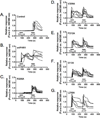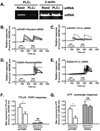Protease-activated receptor 1 (PAR1) coupling to G(q/11) but not to G(i/o) or G(12/13) is mediated by discrete amino acids within the receptor second intracellular loop
- PMID: 22306780
- PMCID: PMC3319227
- DOI: 10.1016/j.cellsig.2012.01.011
Protease-activated receptor 1 (PAR1) coupling to G(q/11) but not to G(i/o) or G(12/13) is mediated by discrete amino acids within the receptor second intracellular loop
Abstract
Protease-activated receptor 1 (PAR1) is an unusual GPCR that interacts with multiple G protein subfamilies (G(q/11), G(i/o), and G(12/13)) and their linked signaling pathways to regulate a broad range of pathophysiological processes. However, the molecular mechanisms whereby PAR1 interacts with multiple G proteins are not well understood. Whether PAR1 interacts with various G proteins at the same, different, or overlapping binding sites is not known. Here we investigated the functional and specific binding interactions between PAR1 and representative members of the G(q/11), G(i/o), and G(12/13) subfamilies. We report that G(q/11) physically and functionally interacts with specific amino acids within the second intracellular (i2) loop of PAR1. We identified five amino acids within the PAR1 i2 loop that, when mutated individually, each markedly reduced PAR1 activation of linked inositol phosphate formation in transfected COS-7 cells (functional PAR1-null cells). Among these mutations, only R205A completely abolished direct G(q/11) binding to PAR1 and also PAR1-directed inositol phosphate and calcium mobilization in COS-7 cells and PAR1-/- primary astrocytes. In stark contrast, none of the PAR1 i2 loop mutations disrupted direct PAR1 binding to either G(o) or G(12), or their functional coupling to linked pertussis toxin-sensitive ERK phosphorylation and C3 toxin-sensitive Rho activation, respectively. In astrocytes, our findings suggest that PAR1-directed calcium signaling involves a newly appreciated G(q/11)-PLCε pathway. In summary, we have identified key molecular determinants for PAR1 interactions with G(q/11), and our findings support a model where G(q/11), G(i/o) or G(12/13) each bind to distinct sites within the cytoplasmic regions of PAR1.
Copyright © 2012 Elsevier Inc. All rights reserved.
Figures






Similar articles
-
N-linked glycosylation of protease-activated receptor-1 at extracellular loop 2 regulates G-protein signaling bias.Proc Natl Acad Sci U S A. 2015 Jul 7;112(27):E3600-8. doi: 10.1073/pnas.1508838112. Epub 2015 Jun 22. Proc Natl Acad Sci U S A. 2015. PMID: 26100877 Free PMC article.
-
PAR1 and PAR2 couple to overlapping and distinct sets of G proteins and linked signaling pathways to differentially regulate cell physiology.Mol Pharmacol. 2010 Jun;77(6):1005-15. doi: 10.1124/mol.109.062018. Epub 2010 Mar 9. Mol Pharmacol. 2010. PMID: 20215560 Free PMC article.
-
Galpha12/13- and rho-dependent activation of phospholipase C-epsilon by lysophosphatidic acid and thrombin receptors.Mol Pharmacol. 2006 Jun;69(6):2068-75. doi: 10.1124/mol.105.017921. Epub 2006 Mar 22. Mol Pharmacol. 2006. PMID: 16554409
-
Regulator of G protein signaling 2 (RGS2) and RGS4 form distinct G protein-dependent complexes with protease activated-receptor 1 (PAR1) in live cells.PLoS One. 2014 Apr 17;9(4):e95355. doi: 10.1371/journal.pone.0095355. eCollection 2014. PLoS One. 2014. PMID: 24743392 Free PMC article.
-
Functional selectivity of G protein signaling by agonist peptides and thrombin for the protease-activated receptor-1.J Biol Chem. 2005 Jul 1;280(26):25048-59. doi: 10.1074/jbc.M414090200. Epub 2005 May 4. J Biol Chem. 2005. PMID: 15878870
Cited by
-
Thrombin regulation of synaptic transmission and plasticity: implications for health and disease.Front Cell Neurosci. 2015 Apr 21;9:151. doi: 10.3389/fncel.2015.00151. eCollection 2015. Front Cell Neurosci. 2015. PMID: 25954157 Free PMC article. Review.
-
Platelet Signaling and Disease: Targeted Therapy for Thrombosis and Other Related Diseases.Pharmacol Rev. 2018 Jul;70(3):526-548. doi: 10.1124/pr.117.014530. Pharmacol Rev. 2018. PMID: 29925522 Free PMC article. Review.
-
Protease induced plasticity: matrix metalloproteinase-1 promotes neurostructural changes through activation of protease activated receptor 1.Sci Rep. 2016 Oct 20;6:35497. doi: 10.1038/srep35497. Sci Rep. 2016. PMID: 27762280 Free PMC article.
-
Thrombin generation and atherosclerosis.J Thromb Thrombolysis. 2014 Jan;37(1):45-55. doi: 10.1007/s11239-013-1026-5. J Thromb Thrombolysis. 2014. PMID: 24241912 Review.
-
Parmodulins inhibit thrombus formation without inducing endothelial injury caused by vorapaxar.Blood. 2015 Mar 19;125(12):1976-85. doi: 10.1182/blood-2014-09-599910. Epub 2015 Jan 13. Blood. 2015. PMID: 25587041 Free PMC article.
References
-
- Vu TK, Hung DT, Wheaton VI, Coughlin SR. Cell. 1991;64:1057–1068. - PubMed
-
- Coughlin SR. J Thromb.Haemost. 2005;3:1800–1814. - PubMed
-
- Gingrich MB, Traynelis SF. Trends in Neurosciences. 2000;23:399–407. - PubMed
-
- Ossovskaya VS, Bunnett NW. Physiol Rev. 2004;84:579–621. - PubMed
-
- Traynelis SF, Trejo J. Curr.Opin.Hematol. 2007;14:230–235. - PubMed
Publication types
MeSH terms
Substances
Grants and funding
LinkOut - more resources
Full Text Sources
Miscellaneous

